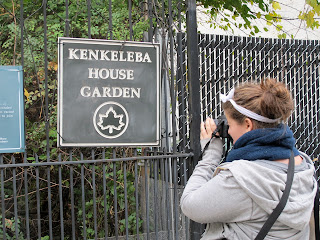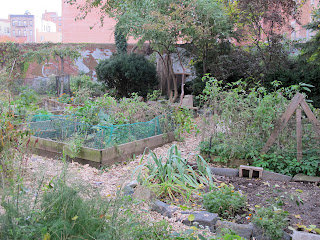Last Thursday BHSEC’s food politics took a field trip. Over the last few weeks our class has been discussing community gardens, and the abundance of these gardens on the lower east side in particular. Community gardens are hard to define, they fall into the cracks of law between public parks and private space. Though some do visit the gardens (as we did) they are mostly enjoyed by members of the surrounding neighborhoods.
In the East Village alone there are 39 gardens -- and that’s only the East Village, there are countless more that span the area of the rest of the five boroughs. In the 1970’s there was a major surge for a gardening movement when financially decrepit neighborhoods became more prone to crime and drugs. During this time in New York City history many landlords abandoned buildings, and these buildings ended up crumbling and empty. The city was losing money fast, and couldn’t afford the upkeep of the abandoned lots, and the number of squatters multiplied. Eventually, these buildings were torn down and the lots after a lot of TLC, became community gardens.
We only got to visit a couple community gardens in the short time our class spanned, but I can honestly say that the ones we did get to see were amazing, and very inspiring. Most gardens are closed at this time in the year, so we only got to go inside two of the gardens, but even just looking through the gates of these gardens, you can tell, a lot of heart and soul has gone into making these gardens what they are. The first one we saw, “Le Petit Versailles” or The Small Versailles, was the smallest garden we saw, but what it lacked in size, it made up in beauty.
These “Cat Eyes,” caught my eye at once, all along the West wall of the garden they stared out from behind vines that climbed up the neighboring building’s wall; it was almost haunting. The garden however, was altogether very sweet, and cozy. It was a small pocket of greenery in an urban metropolis. There were two gardeners who showed us around the garden, and as Tess asked when they would be closing for the winter they excitedly launched into a conversation on their plans to construct a winter igloo so that the weekly poetry readings could continue uninterrupted. Lastly, Tess showed us to a large compost bin, much larger then our own in the BHSEC yard, and explained how the compost was maintained by the state to help encourage reusable resources.
Another Garden we went to was “Kenkeleba Garden,” a very different sort of garden. When first came to the garden it appeared to be locked, but after a few minutes a lovely women informed us that the garden was in fact, not closed at all, and that ‘we should just be careful of rocks on the path.’ This garden was beautiful in an entirely different way from “Le Petit Versailles,” this garden was less of a traditional garden -- rather it was a sculpture garden. Kenkeleba Garden is mostly a sculpture garden, and exhibition space that displays minority artists from a wide variety of backgrounds. We saw many interesting pieces:
The last garden we saw that day was called “El Jardin Del Paraiso” and even though we didn’t get to go in it was clear to once that this Garden was the biggest. The Garden spanned the entire width of block it was on, and easily took the space of two standard tenement houses. All that being said it was lovely. The Garden itself was comprised mostly of grassy lawns. One of the defining fetures of the land was the giant weeping willow tree that had spurn up on the south east corner of the garden. Tess told us that it had to be hundreds of years old, as it was huge. It was amazing. At the base of the wide trunk there was also a tree house. I was particularly amused by this tree house, and wished we could go inside the garden.
Overall the field trip was Amazing and I learned so much about the culture of the lower east side. The Gardens themselves were beautiful and I thought that more then anything I am excited for spring when I can go visit again. I would encourage anyone curious to check them out! Below are some helpful resources to get you started.
Resources:
History of Community Gardens:
List of Gardens:
As a resource for this post I was able to borrow Tess’s copy of “Community Gardens of the Lower East Side,” it was a wonderful read. It supplies a comprehensive history of every garden on the lower East Side, as well as a detailed map. You can pick up a copy at The Saint Marks Bookstore on Saint Marks Place in Manhattan.








No comments:
Post a Comment